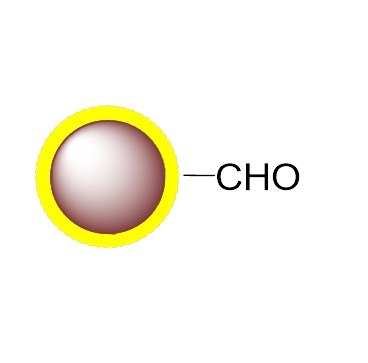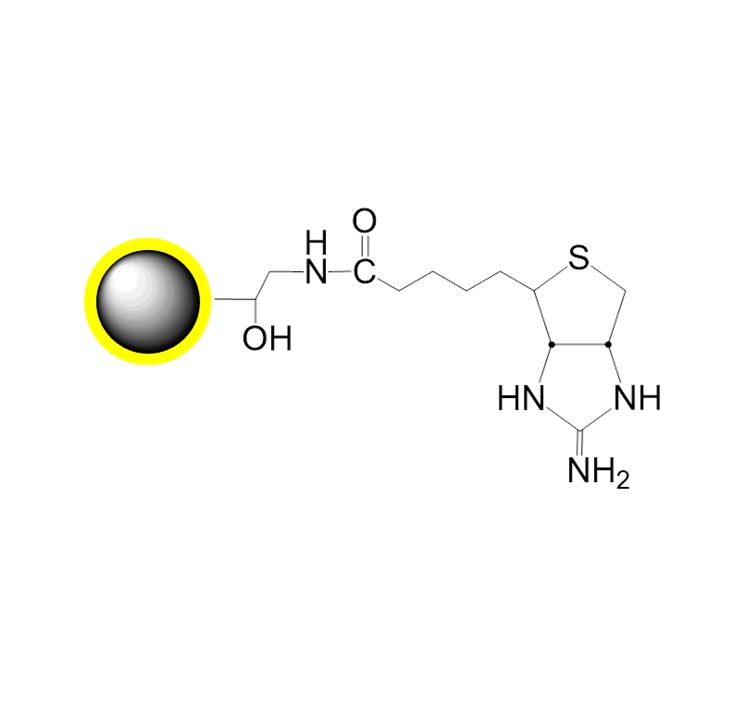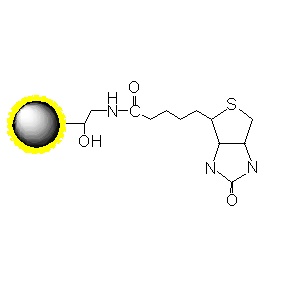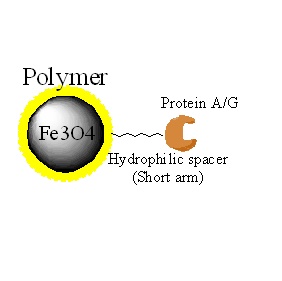|
Ordering information |
|||
|
Name |
Cat. No. |
Vol. |
Scheme |
|
G-CHO |
PMG040-2 |
2 ml |
|
1. Overview
PuriMag? G-CHO, Aldehyde-Functionalized Magnetic Nanoparticles are uniform, polymer-coated superparamagnetic nanoparticles. Their hydrophilic surface ensures excellent dispersibility, low non-specific adsorption, and easy handling in diverse buffers. The high-density aldehyde functional groups enable permanent covalent coupling with primary amine-containing ligands.PuriMag? G-CHO beads are optimal for conjugating proteins and small peptides, including enzymes, antibodies, and amine-modified nucleic acids. They are suitable for magnetic separation applications such as: Affinity enrichment; Protein purification; Immunoprecipitation; Cell sorting.
Features & Advantages:
Broad Coupling Conditions: Efficient conjugation at pH 4–10, 4–25°C, for 2–16 h
Solvent Compatibility: Water-insoluble ligands can be coupled in:Organic solvents (10–30% acetone, dioxane, alcohols, DMF, DMSO)Denaturants (6 M guanidine HCl or 4 M urea in coupling buffer)
Stable covalent bonds with minimal ligand leakage
Generates reusable immunoaffinity matrices
Low non-specific binding
Immobilization capacity: 1–50 mg protein or 0.1–5 mg peptide per gram beads
Applications: Antibody/protein/peptide/DNA/RNA purification; cell sorting; immunoprecipitation
Convenient and rapid coupling
Coupling Mechanism:

2. product description
Product Specifications
Description
Polymer coated Fe3O4 nanoparticles
Particle Size
200 nm
Number of Beads
~1.7×1010 beads/mg
Matrix
Proprietary polymer
Functional group
Aldehyde group
Group density
~300 μmole / g of Beads
Magnetization
60~70 EMU/g
Formulation
10 mg/ml suspension in DI water
Stability
pH 3.5~10, 4~80 ℃, most organic solvents
Storage
1 year at 4~8 ℃. Do not freeze.
3. Instructions for Use
Note: The following protocol exemplifies coupling proteins and/or peptides to PuriMag? Aldehyde-Activated Magnetic Nanoparticles.
Optimization of bead quantity is strongly recommended. Insufficient ligand loading may increase non-specific binding, while excessive loading may cause steric hindrance. For affinity matrices, use 1–50 mg protein or 0.1–5 mg peptide per gram beads. Scale proportionally as needed.
A. Required Materials
1.Magnetic Racks:
For 12×1.5–2 mL tubes (Mrack02)
For 2×50 mL or 2×15 mL tubes (Mrack03)
2.Coupling Buffers:
Soluble Ligands: 0.1 M Sodium Phosphate, pH 7.0
Insoluble Ligands: 0.1 M Sodium Phosphate, pH 7.0, containing:
10–30% acetone, or dioxane, or alcohols, or DMF, or DMSO, or
6 M Guanidine?HCl or 4 M Urea
Note: Minimal ionic strength is critical. Avoid amine-containing buffers (e.g., Tris) or nucleophiles. Storage/wash buffers may contain amines. Prepare sodium cyanoborohydride in a chemical fume hood due to high toxicity.
3.Blocking Buffer: 1 M Tris?HCl, 0.05% NaN?, pH 7.4
4.Wash Buffer: 1 M NaCl, 0.05% NaN?
5.Reducing Agent: 5 M Sodium Cyanoborohydride (NaCNBH? in 1 M NaOH)
B. Bead Preparation
*Note: PuriMag? Aldehyde Beads are supplied as 10 mg/mL suspension in water. Store at 4°C. Vortex thoroughly before use.*
1.Transfer 2 mg beads to a microcentrifuge tube.
2.Place tube on magnetic stand for 1 min. Discard supernatant. Resuspend beads in 50 μL coupling buffer.
3.Repeat Step 2 three times (total 4 washes).
*Note: Use hydrated beads immediately due to functional group instability.*
C. Protein Coupling
1.Dissolve 50–200 μg protein/peptide in 100 μL coupling buffer (soluble or insoluble formulation per ligand solubility). If pre-suspended in other buffers, dilute with 4× volume coupling buffer or perform desalting/dialysis.
*Note: Optimize ligand concentration empirically. Recommended: 0.5–10 mg/mL for proteins; >200 μmol/mL for small peptides.*
2.In fume hood: Add protein solution and 1 μL NaCNBH? solution (10 μL/mL total volume → 50 mM final) to beads. Resuspend and mix by pipetting. Incubate with rotation overnight at RT or 4°C.
3.Wash beads 3× with 1 mL coupling buffer (as in Step B2).
4.Add 0.1–0.5 mL blocking buffer + 0.5–1 μL NaCNBH? (10 μL/mL total volume → 50 mM final). Incubate 1 h at RT or overnight at 4°C.
5.Wash beads 4–6× with 1 mL wash buffer (as in Step 2).
6.Resuspend in PBS with 0.1% NaN? (w/v). Store at 4°C (avoid freezing).
D. General Affinity Purification Protocol
Note: While nucleic acid purification is standardized, protein purification requires target-specific optimization.
1.Transfer optimized bead amount to tube. Separate magnetically (1–3 min), discard supernatant.
*Note: Titrate beads against target abundance. Typical binding: 1–20 μg target protein per mg beads.*
2.Wash beads 3× with 5 bead volumes PBS (30 sec resuspension per wash).
3.Incubate beads with crude sample (1–2 h at RT or optimized temperature).
4.Wash with PBS or 1M NaCl until eluate OD??? < 0.05.
5.Elute target using:
Low pH (2–4)
High pH (10–12)
High salt
Heat
Affinity elution
Boiling in SDS-PAGE buffer
(For research use only!)





